Giant Mine newsletter: November to December 2018
Get the most recent updates on the Giant Mine remediation project.
On this page
Health Effects Monitoring Program update
The Health Effects Monitoring Program completed its baseline sample collection for Yellowknife, Ndilo and Dettah in 2018. These samples measure levels of arsenic in the bodies of residents now so that the researchers can monitor any changes during the remediation work. The research team is currently analyzing the samples of urine and toenail clippings at their laboratory at the University of Ottawa. A total of approximately 2000 individuals, between the ages of 3 to 79 as well as Elders, took part between Fall 2017 and Spring 2018. Participants from the first wave of sampling have already received some of their individual results.
Complete results for individuals who participated in the two waves will be available in 2019. All participants will receive their results in a personal letter from the Principal Investigator, Dr. Laurie Chan. This includes information about any next steps for each individual, if needed to address their results.
Overall results will be shared with the public at community meetings in spring 2019. The Project team will ensure these meetings are communicated through our channels such as this newsletter, public meetings, and other mechanisms, as appropriate. All personal health information will be kept confidential.
For more information on the study, please contact the research team directly at ykhemp@uottawa.ca or visit ykhemp.ca.
North Slave Métis Alliance site tour
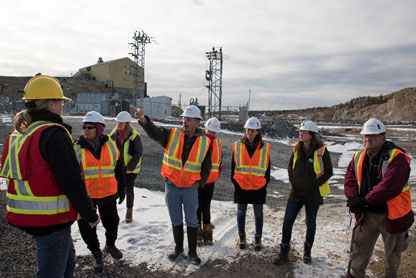
A vital part of the Giant Mine Remediation Project is collaborating with local Indigenous community members. As part of our ongoing engagement, the Project team brought 10 people from the North Slave Métis Alliance on a surface tour of the Giant Mine site on October 5, 2018. The tour allowed members to see how care and maintenance of the site occurs. The Project team also provided an overview of all the elements of the Closure and Reclamation Plan.
Quantitative risk assessment update

In late October, the Giant Mine Remediation Project Team hosted a two- day Quantitative Risk Assessment workshop in Dettah to get more input from partners and interested parties about what should be part of the quantitative risk assessment for the final closure of Giant Mine. Members of the Yellowknives Dene First Nation and North Slave Métis Alliance attended, along with the Giant Mine Oversight Board, Giant Mine Working Group and the Giant Mine Advisory Committee. Everyone worked together to rank the risks identified in the previous session in order of high priority risks to low priority risks for humans, animals and the environment.
Industry Day
On November 26, the Giant Mine Remediation Project Team and Parsons Inc. hosted a one day session geared to help local and Indigenous businesses prepare for upcoming procurement opportunities related to the remediation of the Giant Mine. The goal of the event was provide information about the scope of the GMRP, how the project will be managed and delivered, the anticipated schedule and supply chain needs to improve local business preparedness. In addition to identifying the kind of work that will be required for remediation, this also allowed Parsons to discuss its procurement strategy and give tips on how to successfully participate in a procurement process. Participants were also given time to share their experiences related to bidding on work at the Giant Mine Site, in an effort to make the process easy for bidders going forward. This event was put together by the Giant Mine Remediation Project team, in partnership with the Government of the Northwest Territories, Parsons Inc., Crown-Indigenous Relations and Northern Affairs Canada – NWT Region, and Public Services and Procurement Canada.
Range Lake North School outreach
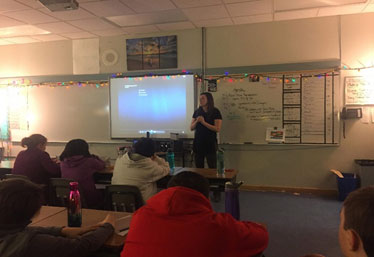
On October 17, 2018, the Giant Mine Remediation Project engagement team's Geneva Irwin and Erika Nyyssonen visited Range Lake North's Grade 7 and 8 classes. The classes were studying remediation and invited the Project team to speak about the Project. The team spoke about the history of Giant Mine, the difference between various forms of arsenic, and where arsenic comes from. They also answered questions from the students about the Project's Closure and Reclamation Plan and gave them an idea of the kinds of jobs that are going to be available at the site in the future.
This outreach is a part of the ongoing commitment of the Project team to engagement. The Project team recognizes the importance of understanding and considering Indigenous and local concerns in order for the remediation of the site to be successful. Feedback from the day was positive and the team will continue to work with interested schools to do more outreach on Giant Mine.
Giant Mine Remediation Project team all staff meeting
In late October, the Giant Mine Remediation Project team held three days of All Staff meetings in Yellowknife. Team members from Crown-Indigenous Relations and Northern Affairs Canada, Public Services and Procurement Canada, Government of the Northwest Territories, and the Main Construction Manager Parsons' Inc, attended, along with consultants from Golder, AECOM and DXB Projects. The first day was devoted to reconciliation-related activities, in keeping with the Truth and Reconciliation Commissions Call to Action to "provide education for management and staff on the history of Aboriginal peoples, including the history and legacy of residential schools".
The Blanket Exercise was one of the activities the team conducted. It explores the nation-to-nation relationship between Indigenous and non-Indigenous peoples in Canada. Blankets were arranged on the floor to represent land and the team members were invited to step into the roles of First Nations, Inuit, and Métis peoples throughout this exercise. Blankets representing Indigenous lands were made smaller and divided throughout the exercise by members in masks representing colonizers, even as some are removed from the exercise to represent loss of life and culture. This was followed by an afternoon with residential school survivors speaking about their personal experiences, as well as a speaker on the effects of intergenerational trauma. The day closed with a Feeding the Fire Ceremony.
While the subject matter was understandably difficult and emotional, the team members expressed how valuable, meaningful and important they found the day. They felt it was helpful to keep in mind during the next two days of meetings, which focused on how the different parties are working together to plan the water licence process.
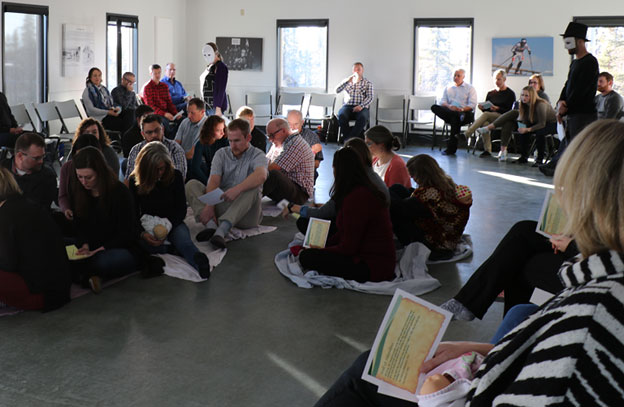
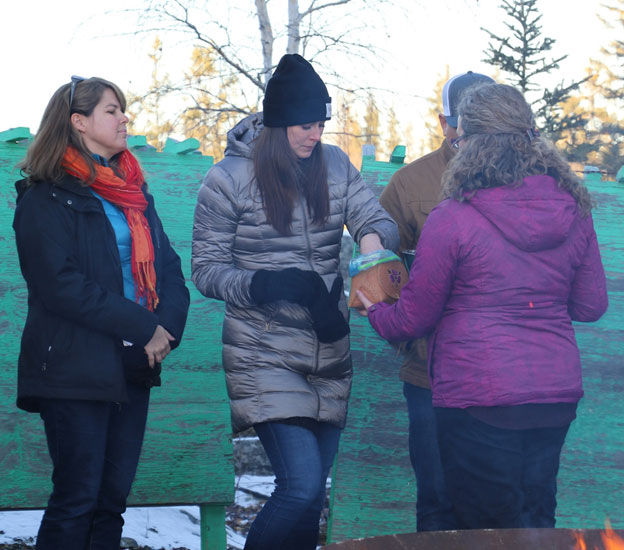
Eco-Canada speaker series
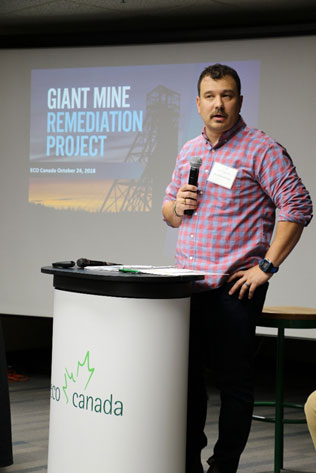
On October 24, 2018, Eco-Canada held one of its speaker's series events in Yellowknife, and they invited the Giant Mine Remediation Project team to participate. Eco-Canada is a not-for-profit organization that works to nurture Canada's growing environmental sector, and their BEAHR Indigenous training programs have been delivered in the Northwest Territories to help grow local environmental competencies and foster green careers. The Project's Engagement Manager, Aaron Braumberger was one of three speakers featured at the event.
In his presentation, Aaron Braumberger discussed the upcoming work for the Project and how the team is working to ensure local and Indigenous residents are ready to benefit from the coming work. He was followed by Parsons Inc.'s Louie Azzolini, the Economic Development Officer for the Main Construction Manager's team, as well as Adrian Paradis from the Canadian Northern Economic Development Agency (CanNor), who also made presentations. All three then participated in a panel discussion so attendees could learn more about how each organization might be able to help or work with them.